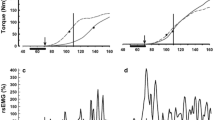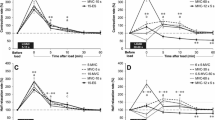Abstract
‘Explosive’ muscle strength or contractile rate of force development (RFD) is a term to describe the ability to rapidly develop muscular force, and can be measured as the slope of the torque–time curve obtained during isometric conditions. Previously, conflicting results have been reported regarding the relationship between contractile RFD and various physiological parameters. One reason for this discrepancy may be that RFD in various time intervals from the onset of contraction is affected by different physiological parameters. The aim of the present study was to investigate the relationship between voluntary contractile RFD in time intervals of 0–10, 0–20,..., 0–250 ms from the onset of contraction and two main parameters: (1) voluntary maximal muscle strength and (2) electrically evoked muscle twitch contractile properties. The main finding was that voluntary RFD became increasingly more dependent on MVC and less dependent on muscle twitch contractile properties as time from the onset of contraction increased. At time intervals later than 90 ms from the onset of contraction maximal muscle strength could account for 52–81% of the variance in voluntary RFD. In the very early time interval (<40 ms from the onset of contraction) voluntary RFD was moderately correlated to the twitch contractile properties of the muscle and was to a less extent related to MVC. The present results suggest that explosive movements with different time spans are influenced by different physiological parameters. This may have important practical implications when designing resistance training programs for specific sports.






Similar content being viewed by others
References
Aagaard P, Simonsen EB, Andersen JL, Magnusson P, Dyhre-Poulsen P (2002) Increased rate of force development and neural drive of human skeletal muscle following resistance training. J Appl Physiol 93:1318–1326
Aagaard P, Thorstensson A (2003) Neuromuscular aspects of exercise—adaptive responses evoked by strength training. In: Kjær M (eds) Textbook of sport medicine. Blackwell, London, pp 70–106
Andersen LL, Andersen JL, Magnusson SP, Suetta C, Madsen JL, Christensen LR, Aagaard P (2005) Changes in the human muscle force-velocity relationship in response to resistance training and subsequent detraining. J Appl Physiol 99(1):87–94
Bell GJ, Petersen SR, Quinney HA, Wenger HA (1989) The effect of velocity-specific strength training on peak torque and anaerobic rowing power. J Sports Sci 7:205–214
Bemben MG, Clasey JL, Massey BH (1990) The effect of the rate of muscle contraction on the force–time curve parameters of male and female subjects. Res Q Exerc Sport 61:96–99
Birch K, Sinnerton S, Reilly T, Lees A (1994) The relation between isometric lifting strength and muscular fitness measures. Ergonomics 37:87–93
Bojsen-Moller J, Magnusson SP, Rasmussen LR, Kjaer M, Aagaard P (2005) Muscle performance during maximal isometric and dynamic contractions is influenced by the stiffness of the tendinous structures. J Appl Physiol 99(3):986–994
Bosco C, Komi PV (1979) Mechanical characteristics and fiber composition of human leg extensor muscles. Eur J Appl Physiol Occup Physiol 41:275–284
Bottinelli R, Canepari M, Pellegrino MA, Reggiani C (1996) Force–velocity properties of human skeletal muscle fibres: myosin heavy chain isoform and temperature dependence. J Physiol 495(Pt 2):573–586
Bottinelli R, Pellegrino MA, Canepari M, Rossi R, Reggiani C (1999) Specific contributions of various muscle fibre types to human muscle performance: an in vitro study. J Electromyogr Kinesiol 9:87–95
Brody IA (1976) Regulation of isometric contraction in skeletal muscle. Exp Neurol 50:673–683
Close RI (1972) Dynamic properties of mammalian skeletal muscles. Physiol Rev 52:129–197
De Luca CJ (1997) The use of surface electromyography in biomechanics. J Appl Biomech 13:135–163
Driss T, Vandewalle H, Le Chevalier JM, Monod H (2002) Force–velocity relationship on a cycle ergometer and knee-extensor strength indices. Can J Appl Physiol 27:250–262
Grabiner MD (1994) Maximum rate of force development is increased by antagonist conditioning contraction. J Appl Physiol 77:807–811
Grimby L, Hannerz J, Hedman B (1981) The fatigue and voluntary discharge properties of single motor units in man. J Physiol 316:545–554
Hakkinen K, Alen M, Komi PV (1985a) Changes in isometric force- and relaxation-time, electromyographic and muscle fibre characteristics of human skeletal muscle during strength training and detraining. Acta Physiol Scand 125:573–585
Hakkinen K, Komi PV (1983) Alterations of mechanical characteristics of human skeletal muscle during strength training. Eur J Appl Physiol Occup Physiol 50:161–172
Hakkinen K, Komi PV, Alen M (1985b) Effect of explosive type strength training on isometric force- and relaxation-time, electromyographic and muscle fibre characteristics of leg extensor muscles. Acta Physiol Scand 125:587–600
Hakkinen K, Komi PV, Tesch PA (1981) Effect of combined concentric and eccentric strength training and detraining on force–time, muscle fiber and metabolic characteristics of leg extensor muscles. Scand J Sports Sci 3:50–58
Hakkinen K, Newton RU, Gordon SE, McCormick M, Volek JS, Nindl BC, Gotshalk LA, Campbell WW, Evans WJ, Hakkinen A, Humphries BJ, Kraemer WJ (1998) Changes in muscle morphology, electromyographic activity, and force production characteristics during progressive strength training in young and older men. J Gerontol A Biol Sci Med Sci 53:B415–B423
Harridge SD, Bottinelli R, Canepari M, Pellegrino MA, Reggiani C, Esbjornsson M, Saltin B (1996) Whole-muscle and single-fibre contractile properties and myosin heavy chain isoforms in humans. Pflugers Arch 432:913–920
Houston ME, Norman RW, Froese EA (1988) Mechanical measures during maximal velocity knee extension exercise and their relation to fibre composition of the human vastus lateralis muscle. Eur J Appl Physiol Occup Physiol 58:1–7
Jaric S, Ristanovic D, Corcos DM (1989) The relationship between muscle kinetic parameters and kinematic variables in a complex movement. Eur J Appl Physiol Occup Physiol 59:370–376
Jensen RL, Freedson PS, Hamill J (1996) The prediction of power and efficiency during near-maximal rowing. Eur J Appl Physiol Occup Physiol 73:98–104
Kugelberg E, Thornell LE (1983) Contraction time, histochemical type, and terminal cisternae volume of rat motor units. Muscle Nerve 6:149–153
Kukolj M, Ropret R, Ugarkovic D, Jaric S (1999) Anthropometric, strength, and power predictors of sprinting performance. J Sports Med Phys Fitness 39:120–122
Larsson L, Moss RL (1993) Maximum velocity of shortening in relation to myosin isoform composition in single fibres from human skeletal muscles. J Physiol 472:595–614
Meckel Y, Atterbom H, Grodjinovsky A, Ben Sira D, Rotstein A (1995) Physiological characteristics of female 100 metre sprinters of different performance levels. J Sports Med Phys Fitness 35:169–175
Mero AP, Luhtanen JT, Viitasalo JH, Komi PV (1981) Relationship between the maximal running velocity, muscle fibre characteristics, force production and force relaxation of sprinters. Scand J Sports Sci 3:16–22
Mirkov DM, Nedeljkovic A, Milanovic S, Jaric S (2004) Muscle strength testing: evaluation of tests of explosive force production. Eur J Appl Physiol 91:147–154
Narici MV, Hoppeler H, Kayser B, Landoni L, Claassen H, Gavardi C, Conti M, Cerretelli P (1996) Human quadriceps cross-sectional area, torque and neural activation during 6 months strength training. Acta Physiol Scand 157:175–186
Paasuke M, Ereline J, Gapeyeva H (2001) Knee extension strength and vertical jumping performance in nordic combined athletes. J Sports Med Phys Fitness 41:354–361
Pincivero DM, Lephart SM, Karunakara RG (1997) Relation between open and closed kinematic chain assessment of knee strength and functional performance. Clin J Sport Med 7:11–16
Sahaly R, Vandewalle H, Driss T, Monod H (2001) Maximal voluntary force and rate of force development in humans—importance of instruction. Eur J Appl Physiol 85:345–350
Saliba L, Hrysomallis C (2001) Isokinetic strength related to jumping but not kicking performance of Australian footballers. J Sci Med Sport 4:336–347
Schantz P, Randall-Fox E, Hutchison W, Tyden A, Astrand PO (1983) Muscle fibre type distribution, muscle cross-sectional area and maximal voluntary strength in humans. Acta Physiol Scand 117:219–226
Schmidtbleicher D (1992) Training for power events. In: Komi PV (eds) Strength and power in sport. Blackwell, London, pp 381–395
Stone MH, Sanborn K, O’Bryant HS, Hartman M, Stone ME, Proulx C, Ward B, Hruby J (2003) Maximum strength-power-performance relationships in collegiate throwers. J Strength Cond Res 17:739–745
Thorstensson A, Karlsson J, Viitasalo JH, Luhtanen P, Komi PV (1976) Effect of strength training on EMG of human skeletal muscle. Acta Physiol Scand 98:232–236
Van Cutsem M, Duchateau J, Hainaut K (1998) Changes in single motor unit behaviour contribute to the increase in contraction speed after dynamic training in humans. J Physiol 513(Pt 1):295–305
Viitasalo JT, Aura O (1984) Seasonal fluctuations of force production in high jumpers. Can J Appl Sport Sci 9:209–213
Wilkie DR (1949) The relation between force and velocity in human muscle. J Physiol 110:249–280
Winter DA (1990) Biomechanics and motor control of human movement. Wiley, New York, pp 11–50
Young WB, Bilby GE (1993) The effect of voluntary effort to influence speed of contraction on strength, muscular power, and hypertrophy development. J Strength Cond Res 7:172–178
Author information
Authors and Affiliations
Corresponding author
Rights and permissions
About this article
Cite this article
Andersen, L.L., Aagaard, P. Influence of maximal muscle strength and intrinsic muscle contractile properties on contractile rate of force development. Eur J Appl Physiol 96, 46–52 (2006). https://doi.org/10.1007/s00421-005-0070-z
Accepted:
Published:
Issue Date:
DOI: https://doi.org/10.1007/s00421-005-0070-z




